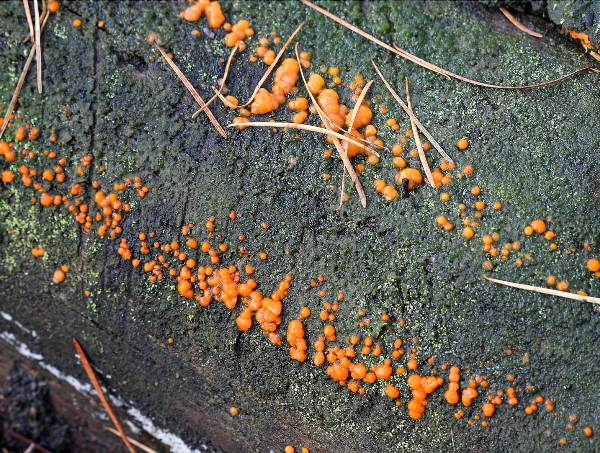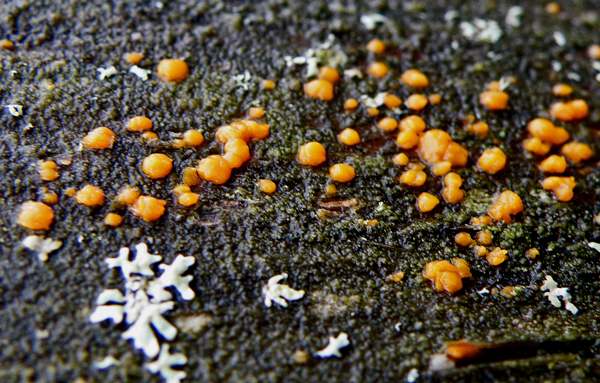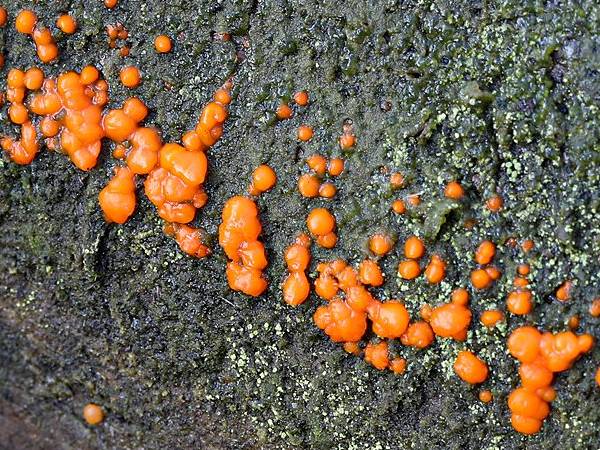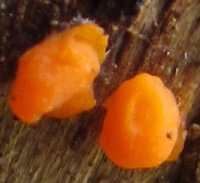Trees Birds Mammals Fish Amphibians Reptiles
Wild Algarve
Bookshop
Dacrymyces stillatus Nees - Common Jellyspot
Phylum: Basidiomycota - Class: Dacrymycetes - Order: Dacrymycetales - Family: Dacrymycetaceae
Distribution - Taxonomic History - Etymology - Identification - Reference Sources

Gregarious or in large merging groups on dead broadleaf or conifer wood, including fence posts and rails, decking and garden furniture as well as fallen trunks and branches, this common fungus displays a preference for timber that is already fairly well rotted.
The fruitbodies can appear at any time of the year during periods of wet weather; this is also a characteristic of many other members of the order Dacrymycetales.

Distribution
Common and widespread in Britain and Ireland, Dacrymyces stillatus occurs also throughout mainland Europe and many other parts of the world including North America.
Taxonomic history
In 1816 German mycologist Christian Gottfried Daniel Nees von Esenbeck (1776 -1858) described Common Jellyspot fungus and gave it the binomial scientific name Dacrymyces stillatus, which remains its generally-accepted name.
Synonyms of Dacrymyces stillatus include Dacrymyces deliquescens, Dacrymyces lacrymalis, Tremella lacrymalis, Tremella abietina Pers., Calloria stillata (Nees) Fr., and Dacrymyces abietinus (Pers.) J. Schröt.
Dacrymyces stillatus is the type species of the genus Dacrymyces.

Etymology
Set up by Nees in 1816, the genus Dacrymyces is named from Dacry- meaning a tear (as in weeping) and -myces meaning fungus, while the specific epithet stillatus means poured or dripped. Hence Dacrymyces stillatus means teardrop-like fungi that look as though they have dripped on to the substrate.
Identification guide

|
Fruitbody
Dull orange-yellow when moist and fresh, becoming more brown and translucent with age; cushion-shaped blobs, slightly flattened; 1 to 8mm across and up to 4mm tall. |
| |
Spores
Elongated ellipsoidal to sausage-shaped, smooth, 14-17 x 5-6 μm; 3-septate (with three cross-walls) at maturity; amyloid.
Spore mass
White. |
Odour/taste |
Not distinctive. |
Habitat & Ecological role |
On rotting trunks and stumps of dead broadleaf trees and conifers. |
Season |
Fruiting in wet weather through most of the year in Britain and Ireland. |
Similar species |
Dacrymyces chrysospermus, another orange jelly-like species, has a rudimentary cup-on-a-stem fruitbody rather than a cushion-like form.
Tremella mesenterica produces fruitbodies of similar colour but they are larger and generally convoluted and lobed. |
Reference Sources
Fascinated by Fungi, 2nd Edition, Pat O'Reilly 2016, reprinted by Coch-y-bonddu Books in 2022.
Dictionary of the Fungi; Paul M. Kirk, Paul F. Cannon, David W. Minter and J. A. Stalpers; CABI, 2008
Taxonomic history and synonym information on these pages is drawn from many sources but in particular from the British Mycological Society's GB Checklist of Fungi.
Acknowledgements
This page includes pictures kindly contributed by Tony Mellor.
Top of page...
Fascinated by Fungi. Back by popular demand, Pat O'Reilly's best-selling 450-page hardback book is available now. The latest second edition was republished with a sparkling new cover design in September 2022 by Coch-y-Bonddu Books. Full details and copies are available from the publisher's online bookshop...